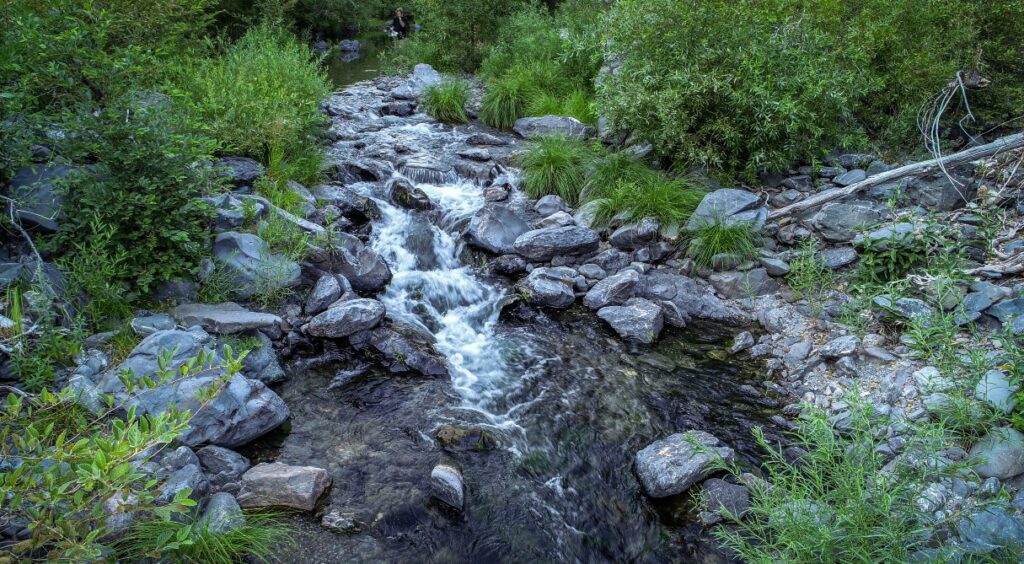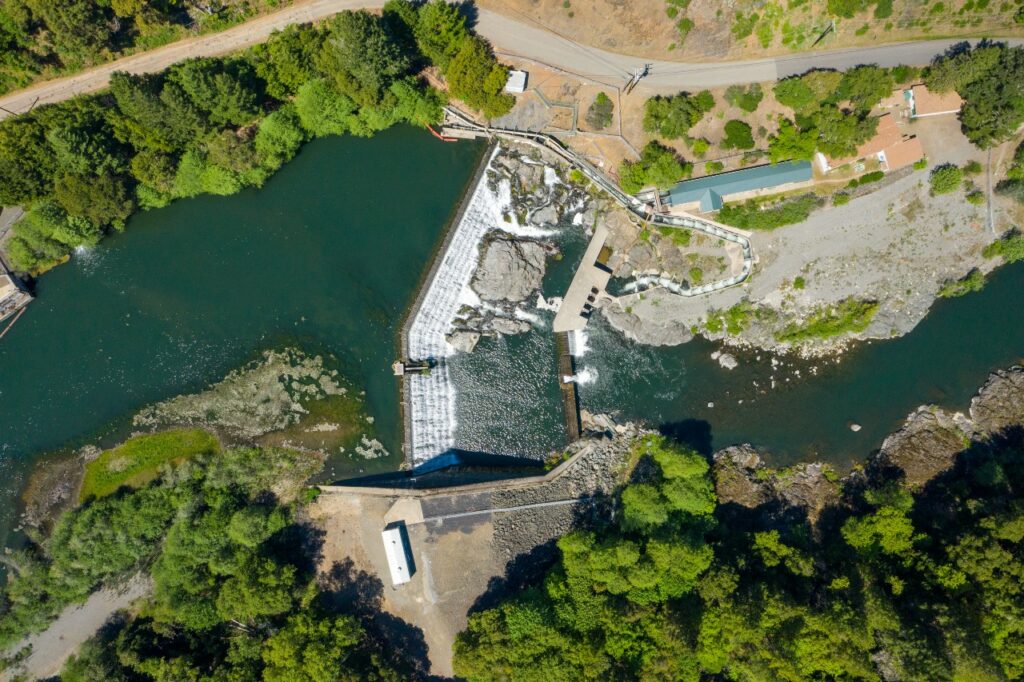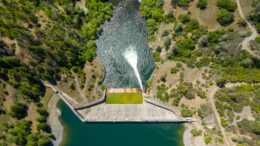This summer crews will break ground on the first of four dam removals along the Klamath River in California and Oregon. The dam-removal and river-restoration effort over the next two years is the largest of its kind, and river advocates hope more will follow.
They may not have to wait long. Up next in the region could be two dams on the mainstem of Northern California’s Eel River.
The Eel River is the third-largest river basin in the state and once had the largest runs of salmon and steelhead on the North Coast. Both Chinook and steelhead are listed as threatened under the Endangered Species Act.
Citing this and other environmental and safety concerns, the river advocacy nonprofit American Rivers this week listed the Eel as one of the 10 most endangered rivers in the United States. It shares that distinction with the Colorado River, which faces threats from climate change and outdated management, and the Ohio River, which is at risk from toxic pollution.
The removal of Scott Dam and Cape Horn Dam could help boost populations of Chinook and steelhead by providing access to hundreds of miles of prime, cold-water spawning and rearing habitat, acutely needed because climate change can push water temperatures above what’s tolerable for salmonids. The dams, known as the Potter Valley Project, belong to power company PG&E as part of a hydroelectric facility that also includes a transbasin diversion, which sends water through a 1-mile-long tunnel to the Russian River to irrigate fields in Potter Valley and provide water for downstream users in Sonoma County.
The small, 9.4-megawatt hydroelectric project has been economically unprofitable for years, and after PG&E found no willing buyers, it declined to renew its operating license in 2019. An equipment failure in the summer of 2022 stopped power production. A draft plan for surrender and decommissioning is expected at the end of the year. But it doesn’t guarantee either dam’s removal.
“Decommissioning can just mean locking the gates and walking away,” says Charlie Schneider, the Lost Coast project manager for California Trout. “Or it can mean full dam-facility removals.”
It can also include something in between, but Alicia Hamann, executive director of Friends of the Eel River, hopes the Federal Energy Regulatory Committee, which oversees regulation of hydroelectric dams, will require full removal of the project.
“It would be highly unusual for FERC to allow PG&E to lock it up and walk away,” says Hamann. The project has risks not just to fish, but potential public safety hazards as well. Looming questions include whether all or some of the project would need to be removed and what would happen to the water diversion.
Fish on the Brink
Data suggests that the Eel River once teemed with salmonids, with estimated annual runs of more than 1 million salmon and steelhead, including some 800,000 Chinook. Now those fish populations are between 1% and 3% of their historic numbers.
Experts attribute the declines to a combination of pressures, including dams, logging, grazing, and the introduction of the Sacramento pikeminnow, a salmon predator.
A report from fisheries biologists at the U.C. Davis Center for Watershed Sciences found “that coho salmon, Chinook salmon and steelhead are all on a trajectory towards extinction in the Eel River basin, with only winter steelhead being widely enough distributed and abundant enough to persist beyond the next 50 years.”
What role dams have played isn’t easy to calculate, but the 95-foot-tall Cape Horn Dam, constructed in 1908, has fish passage that experts consider outdated and inefficient.
“We know that the fish ladder isn’t effective at passing fish,” says Schneider, “so almost certainly some of them are getting to that concrete wall in the river and turning around and maybe spawning in more marginal habitats.”
The fish ladder fails to operate when the river has high flows, and it can clog with debris, forcing it to be temporarily shut down.
“There’s a structure at the base of the fish ladder called ‘the hotel’ where the fish enter and then get oriented and find the trigger flow to go the right direction up the fish ladder,” says Hamann. “And that entire structure can get completely inundated.”
There’s also no protection from predators, “which makes it like an all-you-can-eat buffet for otters,” she says.
If fish do clear the ladder, they then hit the 141-foot-tall Scott Dam 12 miles upstream. This is the end of the line. Scott Dam, which was erected in 1922, contains no fish passage and blocks about 288 miles of high-quality spawning and rearing habitat.

While that’s only about 10% of the whole watershed, it’s among the best areas for these fish.
“Based on our thermal and geomorphic habitat assessments, the blocked Upper Mainstem generally contains a higher proportion of suitable habitat for all freshwater salmonid life stages than much of the rest of the Eel River Basin,” found researchers from the National Marine Fisheries Service and other institutions in a study published in the Canadian Journal of Fisheries and Aquatic Science in 2021.
That’s because of the gravelly sediment that’s ideal for spawning, the availability of food, and the temperature of the water.
“The habitat in the upper mainstem Eel River watershed provides cold-water refugia in tributaries over summertime for steelhead trout as well as ample spawning grounds for Chinook salmon and steelhead trout,” confirmed researchers of a study published in Northwest Science in 2020.
The colder water also can help protect them from invasive pike minnows, who Schneider says are better adapted to warmer conditions.
The population declines have been a loss for recreational and commercial fishers, as well as Tribes.
“We’re really in crisis mode,” says Adam Canter, natural resources director of the Wiyot Tribe, whose ancestral lands encompass the lower Eel River watershed. “The Tribe has lost a cultural and subsistence icon by not being able to fish for Chinook, coho and steelhead as they used to.”
Lamprey, whose numbers have also declined significantly, are a species of special concern in California — and are especially important for the Wiyot Tribe.
“Pacific lamprey are a really culturally important food for the Tribe,” says Canter. Settlers mistook the long, slender fish for eels and incorrectly gave the river its English name for them. Like Chinook and steelhead, lamprey historically used the habitat above Scott dam as well and would benefit from the increased habitat.
Shaky Ground
Declining fish numbers aren’t the only problem.
Friends of the Eel River also worries about seismic concerns at Scott Dam, which sits along a fault capable of producing a magnitude 7 earthquake. When engineers built the dam in the 1920s, they realized that the bedrock they were attempting to secure to part of the southern abutment was in fact a boulder that’s part of a very slow but active landslide.
“So they decided to just re-engineer the dam to go right in front of that giant moving boulder,” says Hamann. “We commissioned a study back in 2018 evaluating that landslide and trying to figure out how much of a risk that is to dam safety and reliability. Miller Pacific Engineering concluded for us that it is a quite serious concern and that PG&E should be evaluating the seismic risk in tandem with that landslide.”
Recent moves from the PG&E show that it’s aware of some seismic issues.
In spring the company usually closes spillway gates at the dam to increase the amount of water behind the dam during periods of high runoff. But this March PG&E announced that it wouldn’t close the gates.
“Keeping the spillway gates open at Scott Dam from this point forward allows us to reduce potential risk around seismic performance,” the company said in a press release. “New information and updated analyses suggest the level of risk around seismic performance at Scott Dam is greater than the previous evaluation.”
Basin Water Issues
If the dams are removed, it remains unclear how authorities will resolve the issue of the transbasin water diversion.
As it is now, “The Russian River gets all the benefits from this project. The Eel gets all the impacts. How is that fair?” says Schneider.

A few years ago a group of stakeholders from the Eel and Russian river watersheds, who called themselves the Two Basin Solution Partnership, tried to find a way to improve conditions in the Eel while maintaining the water diversion to the Russian River. The group had hoped to purchase the project, remove Scott Dam, and continue a diversion with less ecological harm.
“Unfortunately, they just weren’t able to come up with the necessary funding to complete the studies needed for that process,” says Hamann.
There may be other options to remove both dams while continuing to divert some amount of water. But that’s not popular with everyone, including the Wiyot.
“The Tribe wants to see the dams come down and the water diversion no longer used,” says Canter. “The Tribe really just wants to see the river back to its natural state. All that cold water being diverted hurts not just fish but also contributes to increased water temperatures, which then promotes toxic algal blooms and other diseases that can be bad for humans, pets, fish — everyone alike.”
He says the Tribe would support efforts to replace that lost water by investing in more water storage and conservation in the Russian River. “The Tribe certainly doesn’t want them high and dry,” he says. “We have to acknowledge that they’ve been in that water regime for over 100 years now, but it’s come with a big cost.”
Before dam removal could happen, though, there are a lot of other steps.
PG&E will submit its draft plan for decommissioning to FERC at the end of this year, and then there’ll be stakeholder outreach, consultations and public comments, with the final plan due in 2025.
“The state is going to have to issue a clean water certification,” says Hamann. “The water boards are probably going to have to get involved when it comes to straightening out water rights and what happens to those with the end of this project. If we all moved really quickly and all the bureaucratic ducks were lined up and fell just right, we could see those dams out of there by 2030.”
That, she says, is the most optimistic timeline.
For the Wiyot, it would be the best scenario.
“By restoring the river back to health and removing the dams, it would not only be restoring our animal and plant relatives that are associated with the river,” says Canter. “But also our culture and our human health as well.”
Previously in The Revelator:
Klamath Countdown: Researchers Hustle Before Largest Dam-Removal Project Begins


